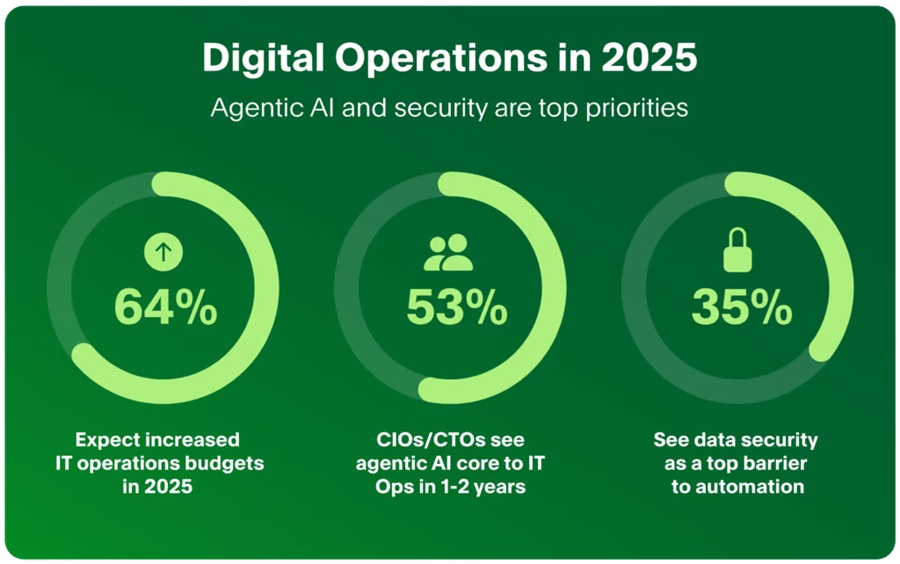A large majority (79%) believe the current service desk model will be unrecognizable within three years, and nearly as many (77%) say new technologies will render it redundant by 2027, according to The Death (and Rebirth) of the Service Desk, a report from Nexthink ...
Open source dominance continues in observability, according to the Observability Survey from Grafana Labs. A remarkable 75% of respondents are now using open source licensing for observability, with 70% reporting that their organizations use both Prometheus and OpenTelemetry in some capacity. Half of all organizations increased their investments in both technologies for the second year in a row ...
Significant improvements in operational resilience, more effective use of automation and faster time to market are driving optimism about IT spending in 2025, with a majority of leaders expecting their budgets to increase year-over-year, according to the 2025 State of Digital Operations Report from PagerDuty ...

Are they simply number crunchers confined to back-office support, or are they the strategic influencers shaping the future of your enterprise? The reality is that data analysts are far more the latter. In fact, 94% of analysts agree their role is pivotal to making high-level business decisions, proving that they are becoming indispensable partners in shaping strategy ...
Today's enterprises exist in rapidly growing, complex IT landscapes that can inadvertently create silos and lead to the accumulation of disparate tools. To successfully manage such growth, these organizations must realize the requisite shift in corporate culture and workflow management needed to build trust in new technologies. This is particularly true in cases where enterprises are turning to automation and autonomic IT to offload the burden from IT professionals. This interplay between technology and culture is crucial in guiding teams using AIOps and observability solutions to proactively manage operations and transition toward a machine-driven IT ecosystem ...
Gartner identified the top data and analytics (D&A) trends for 2025 that are driving the emergence of a wide range of challenges, including organizational and human issues ...
Traditional network monitoring, while valuable, often falls short in providing the context needed to truly understand network behavior. This is where observability shines. In this blog, we'll compare and contrast traditional network monitoring and observability — highlighting the benefits of this evolving approach ...
A recent Rocket Software and Foundry study found that just 28% of organizations fully leverage their mainframe data, a concerning statistic given its critical role in powering AI models, predictive analytics, and informed decision-making ...
What kind of ROI is your organization seeing on its technology investments? If your answer is "it's complicated," you're not alone. According to a recent study conducted by Apptio ... there is a disconnect between enterprise technology spending and organizations' ability to measure the results ...
In today’s data and AI driven world, enterprises across industries are utilizing AI to invent new business models, reimagine business and achieve efficiency in operations. However, enterprises may face challenges like flawed or biased AI decisions, sensitive data breaches and rising regulatory risks ...
In MEAN TIME TO INSIGHT Episode 12, Shamus McGillicuddy, VP of Research, Network Infrastructure and Operations, at EMA discusses purchasing new network observability solutions....
There's an image problem with mobile app security. While it's critical for highly regulated industries like financial services, it is often overlooked in others. This usually comes down to development priorities, which typically fall into three categories: user experience, app performance, and app security. When dealing with finite resources such as time, shifting priorities, and team skill sets, engineering teams often have to prioritize one over the others. Usually, security is the odd man out ...

IT outages, caused by poor-quality software updates, are no longer rare incidents but rather frequent occurrences, directly impacting over half of US consumers. According to the 2024 Software Failure Sentiment Report from Harness, many now equate these failures to critical public health crises ...
In just a few months, Google will again head to Washington DC and meet with the government for a two-week remedy trial to cement the fate of what happens to Chrome and its search business in the face of ongoing antitrust court case(s). Or, Google may proactively decide to make changes, putting the power in its hands to outline a suitable remedy. Regardless of the outcome, one thing is sure: there will be far more implications for AI than just a shift in Google's Search business ...

In today's fast-paced digital world, Application Performance Monitoring (APM) is crucial for maintaining the health of an organization's digital ecosystem. However, the complexities of modern IT environments, including distributed architectures, hybrid clouds, and dynamic workloads, present significant challenges ... This blog explores the challenges of implementing application performance monitoring (APM) and offers strategies for overcoming them ...
